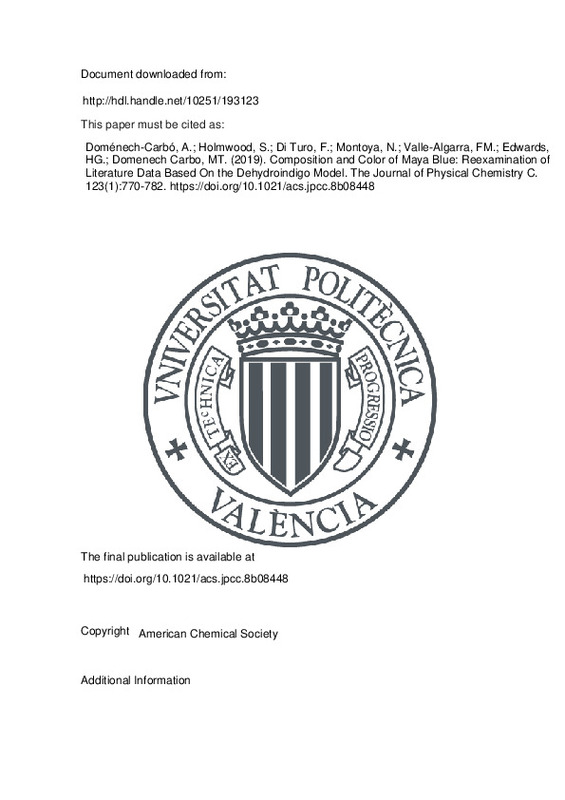JavaScript is disabled for your browser. Some features of this site may not work without it.
Buscar en RiuNet
Listar
Mi cuenta
Estadísticas
Ayuda RiuNet
Admin. UPV
Composition and Color of Maya Blue: Reexamination of Literature Data Based On the Dehydroindigo Model
Mostrar el registro sencillo del ítem
Ficheros en el ítem
| dc.contributor.author | Doménech-Carbó, Antonio
|
es_ES |
| dc.contributor.author | Holmwood, Sigrid
|
es_ES |
| dc.contributor.author | Di Turo, Francesca
|
es_ES |
| dc.contributor.author | Montoya, Noemí
|
es_ES |
| dc.contributor.author | Valle-Algarra, Francisco Manuel
|
es_ES |
| dc.contributor.author | Edwards, Howell G.M.
|
es_ES |
| dc.contributor.author | Domenech Carbo, Mª Teresa
|
es_ES |
| dc.date.accessioned | 2023-05-04T18:01:44Z | |
| dc.date.available | 2023-05-04T18:01:44Z | |
| dc.date.issued | 2019-01-10 | es_ES |
| dc.identifier.issn | 1932-7447 | es_ES |
| dc.identifier.uri | http://hdl.handle.net/10251/193123 | |
| dc.description.abstract | [EN] An analysis of literature data studying the composition and color of Maya blue (MB) type materials prepared from indigo, dehydroindigo, and different aluminosilicates, accompanied by new spectral data, is presented. After thermal treatment at above 100 degrees C, indigo-based specimens displayed Raman and UV-vis spectroscopic features common to those of equivalent dehydroindigo-based replicants, thus supporting the socalled dehydroindigo model (J. Phys. Chem. B 2006, 110, 6027-6039) in which the dehydroindigo/indigo ratio, increasing with temperature, is crucial to determine the color of MB and its variability. The current analysis supports the view of MB as a polyfunctional hybrid material just characterized by the presence of different organic components, each one distributed in topological isomers differently attached to the clay support. On the basis of the comparison of spectral data for different channeled silicates (among others, palygorskite, sepiolite, and montmorillonite clays, and different zeolites), we proposed a view on the color characteristics of Maya blue-type specimens as defined by the compromise between trapping ability for indigo molecules and facility to promote the oxidation of indigo to dehydroindigo. | es_ES |
| dc.description.sponsorship | Project CTQ2017-85317-C2-1-P, supported with Ministerio de Economia, Industria y Competitividad (MINECO), Fondo Europeo de Desarrollo Regional (ERDF), and Agencia Estatal de Investigacion (AEI) is gratefully acknowledged. | es_ES |
| dc.language | Inglés | es_ES |
| dc.publisher | American Chemical Society | es_ES |
| dc.relation.ispartof | The Journal of Physical Chemistry C | es_ES |
| dc.rights | Reserva de todos los derechos | es_ES |
| dc.subject.classification | PINTURA | es_ES |
| dc.title | Composition and Color of Maya Blue: Reexamination of Literature Data Based On the Dehydroindigo Model | es_ES |
| dc.type | Artículo | es_ES |
| dc.identifier.doi | 10.1021/acs.jpcc.8b08448 | es_ES |
| dc.relation.projectID | info:eu-repo/grantAgreement/AEI//CTQ2017-85317-C2-1-P-AR//APLICACIÓN DE TÉCNICAS AVANZADAS DE MICROSCOPIA EN EL ESTUDIO DEL PATRIMONIO CERÁMICO Y VITREO/ | es_ES |
| dc.rights.accessRights | Abierto | es_ES |
| dc.contributor.affiliation | Universitat Politècnica de València. Facultad de Bellas Artes - Facultat de Belles Arts | es_ES |
| dc.description.bibliographicCitation | Doménech-Carbó, A.; Holmwood, S.; Di Turo, F.; Montoya, N.; Valle-Algarra, FM.; Edwards, HG.; Domenech Carbo, MT. (2019). Composition and Color of Maya Blue: Reexamination of Literature Data Based On the Dehydroindigo Model. The Journal of Physical Chemistry C. 123(1):770-782. https://doi.org/10.1021/acs.jpcc.8b08448 | es_ES |
| dc.description.accrualMethod | S | es_ES |
| dc.relation.publisherversion | https://doi.org/10.1021/acs.jpcc.8b08448 | es_ES |
| dc.description.upvformatpinicio | 770 | es_ES |
| dc.description.upvformatpfin | 782 | es_ES |
| dc.type.version | info:eu-repo/semantics/publishedVersion | es_ES |
| dc.description.volume | 123 | es_ES |
| dc.description.issue | 1 | es_ES |
| dc.relation.pasarela | S\407382 | es_ES |
| dc.contributor.funder | AGENCIA ESTATAL DE INVESTIGACION | es_ES |
| dc.contributor.funder | European Regional Development Fund | es_ES |







![[Cerrado]](/themes/UPV/images/candado.png)

